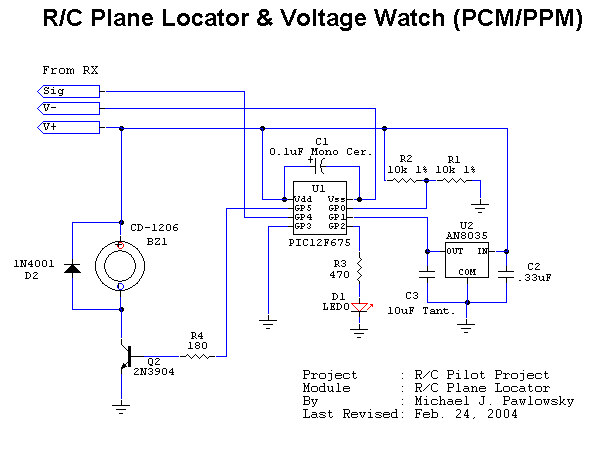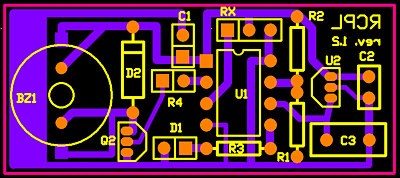R/C Plane Locator and Voltage Watch (PPM & PCM)
The R/C Plane Locator is an audio beacon used to locate r/c aircraft in hard to find places. As many have already experienced, locating a downed plane in a field of tall grass can be very difficult. Or perhaps you don't know if you should be looking up in the trees or down between the bushes. The RCPL will assist you by playing a tri-note beacon and flashing an LED. Listen for the sound and you will have an aid in locating your vehicle. Don't wait until you've lost a plane to build one, by then it's too late.
What makes the RCPL different then other Plane Locator devices? Well most importantly is that it will work with PCM receivers. So far, all of the ones currently on the market or plans on the web do not. It also incorporates a low voltage detector. When the battery goes below 4.4V and longer tri-note audio beacon will sound and the LED will flash to let you know it's time to land.
When in "plane down" mode, the beacon will sound every 5 seconds as long as the batteries remain fully charged (4.8V and over). As the battery goes down in voltage the period between beacons is extended, saving battery power to enable the RCPL to keep beaconing as long as possible. Using an average 600mah battery pack, the RCPL will beacon for over 12 hours. At that point beacons are emitted at intervals of approximately 1 minute.
Setting up the RCPL for PCM requires the use of a spare channel on your R/C receiver. Insert the servo lead into a spare channel. Go to the settings mode of your R/C transmitter and raise the endpoint and sub-trim for that channel to its maximum setting. In the failsafe (F/S) setting, set that channel to go to the maximum when F/S is engaged.
Now you will have two ways to engage the RCPL. First by simply raising the channel's control to the maximum setting or by turning off your radio.
Building the RCPL is very easy and can be done using Vero board. There are only 10 components.
RCPL uses Microchip's PC12F675 with internal 4Mhz oscillator and ADC pins.
The code for the 12F675 was written in PicBasic Pro. A HEX file is also available if you do not have the compiler.
There is one small issue when burning the 12F675 with the hex file. A calibration value for the internal oscillator is stored in the last word of code space by Microchip when it leaves the plant. That word needs to be read from the PIC before anything else and then placed in the last word of the hex file (at position 7FE-7FF).
All files are avalaible for download via a web interface to the anonymous cvs server at: SourceForge.

Bill of Materials
Item Count Label-Value Attributes Designation
1 1 CD-1206 SIP2 BZ1
Digikey 102-1150-ND
2 1 0.1uF Mono Cer. SIP2 C1
DigiKey: P4923
3 1 .33uF RAD0.2 C2
DigiKey: 399-1442
4 1 10uF Tant. RAD0.2 C3
DigiKey: 399-1360
5 1 LED0 SIP2 D1
6 1 1N4001 DIODE0.4 D2
DigiKey: 1N4001RLOSCT-ND
7 1 2N3904 TO-92B Q2
DigiKey: 497-2395-ND
8 2 10k 1% AXIAL0.4 R1,R2
DigiKey: 10.0KXBK-ND
9 1 470 AXIAL0.4 R3
DigiKey 470KQTR-ND
10 1 180 AXIAL0.4 R4
DigiKey: 180QBK-ND
11 1 PIC12F675 DIP8 U1
PIC12F675-E/P-ND
12 1 AN8035 TO-92B U2
DigiKey: AN8035
